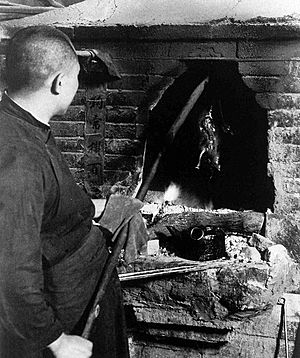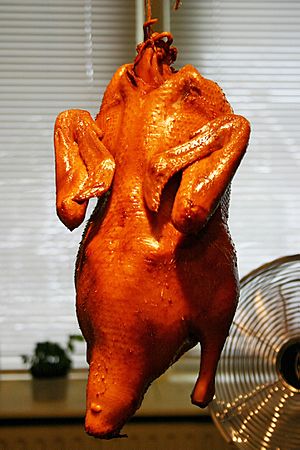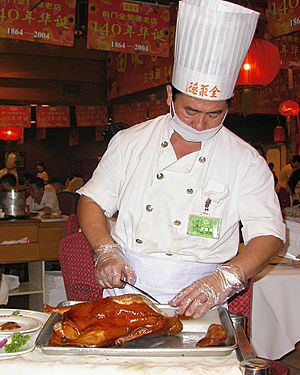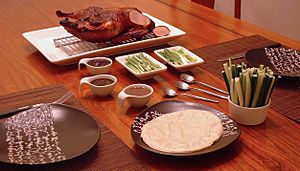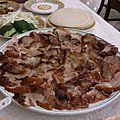Peking duck facts for kids
Peking duck is a famous dish from Beijing, China. It has been enjoyed for a very long time, even when emperors ruled China. This special duck dish is known for its thin, crispy skin. Often, the skin is the main part served, with just a little meat. A chef usually slices it right in front of you!
Ducks raised especially for this dish are prepared carefully. They are seasoned and then roasted in a special oven. People often eat Peking duck with spring onions, cucumber, and a sweet bean sauce. All these ingredients are wrapped inside thin pancakes. Sometimes, pickled radish is added too.
Contents
History of Peking Duck
People in China have been roasting ducks since ancient times. A type of roast duck was even made for the Emperor of China during the Yuan dynasty (around 1271–1368). This dish was first called "shāo yāzi." It was mentioned in a cooking book in 1330 by a person who checked the imperial kitchen.
The Peking roast duck we know today became popular during the later Ming dynasty (1368–1644). By then, it was a main dish served in the emperor's court. The very first restaurant to specialize in Peking duck, called Bianyifang, opened in Beijing in 1416.
During the Qing dynasty (1644–1912), especially from 1736 to 1796, Peking duck became popular among rich families. Poets and scholars even wrote poems about how much they loved it! One poem from Beijing said, "Fill your plates with roast duck."
In 1864, the Quanjude restaurant opened in Beijing. Its founder, Yang Quanren, created a new way to roast ducks using a "hung oven."
By the mid-1900s, Peking duck became a symbol of China. Many tourists and important visitors loved it. For example, Henry Kissinger, who was a top official from the United States, ate Peking duck during his first visit to China in 1971. He loved it so much that he came back just to eat it again after an important Chinese leader passed away. Other world leaders, like Fidel Castro from Cuba and Helmut Kohl from Germany, also enjoyed Peking duck at Quanjude.
Today, two of the most famous restaurants in Beijing that serve Peking duck are Quanjude and Bianyifang. Both are very old and well-known. Quanjude uses the "hung oven" method, while Bianyifang uses the older "closed oven" method.
How Peking Duck is Prepared
Raising the Ducks
The ducks used for Peking duck originally came from Nanjing. They were large, had black feathers, and lived near canals.
When China's capital moved to Beijing, more boats traveled on the waterways. These boats often spilled water into smaller canals, creating perfect homes for ducks. Over time, Chinese farmers developed a special breed of duck. Today, Peking duck is made from the American Pekin duck.
Young ducks are raised freely for about 45 days. Then, for the next 15–20 days, they are given extra food about four times a day. This special feeding makes the ducks weigh about 5–7 kilograms (11–15 pounds). Because of this feeding, the duck is sometimes called "Peking stuffed duck."
Cooking the Duck
First, the plump ducks are prepared. They are cleaned very well. Air is pumped under the skin through the neck. This separates the skin from the fat, which helps the skin become crispy.
Next, the duck is quickly dipped in boiling water for a few minutes. Then, it is hung up to dry. This makes the skin tighter. While hanging, the duck is coated with a thin, runny syrup. The inside is also rinsed again. A second layer of glaze, made from soy sauce, five-spice powder, and more syrup, is put on the duck, both inside and out. The duck then hangs for 24 hours in a cool, dry place. Finally, it is roasted in an oven until its skin turns a shiny brown.
Chefs around the world have also created their own recipes to make Peking duck at home.
Closed-Oven Style
Peking duck was first roasted in a closed oven. The Bianyifang restaurant still uses this traditional method. A closed oven is built from bricks and has metal grates inside. The oven is heated by burning straw at the bottom. Once the fire goes out, the duck is placed inside. The heat trapped in the oven slowly cooks the meat. Controlling the heat is very important. In this style, the duck meat stays juicy and tender because the fat under the skin mixes well with the meat.
Open-Oven Style
The open oven, also called a "hung oven," was developed in the emperor's kitchens during the Qing Dynasty. The Quanjude restaurant chain uses this method. This oven can roast up to 20 ducks at once! It uses an open fire fueled by hardwood from peach or pear trees. The ducks hang on hooks above the fire and roast at a very hot temperature (about 270°C or 525°F) for 30–40 minutes. While they are cooking, the chef might use a pole to move each duck closer to the fire for short times. In this open-oven style, the fat usually melts away, making the skin extra crispy.
How Peking Duck is Served
Peking duck is usually sliced and served in front of the guests in three steps. First, thin slices of crispy duck skin are served. You can dip them in sugar and sweet bean sauce. The skin is best eaten hot and crunchy.
Next, the duck meat is served with warm, steamed pancakes. There are also different vegetables, usually sliced cucumber and spring onion. Traditionally, you dip a slice of duck into the sauce, then place it on a pancake with cucumber and spring onion. You roll up the pancake and eat it with your hands or chopsticks.
The remaining duck bones and some meat, called the "carved duck," can be used in different ways. The most common way is to cook it in a broth with ingredients like Chinese cabbage and soft tofu. It can also be stir-fried with sweet bean sauce or quickly cooked with salt and pepper. Sometimes, customers can take the carved duck home.
Famous Restaurants
Many restaurants in Beijing are famous for Peking duck. Some examples include Quanjude, Bianyifang, and Dadong Kaoyadian. Quanjude and Bianyifang are especially well-known because they have been serving high-quality duck for centuries. They are considered "old brand names" in China. Quanjude has even been recognized worldwide.
Outside of China, some restaurants also specialize in Peking duck. Duck Chang's Restaurant, opened in 1975 in the United States, was the first Chinese restaurant there to serve Peking duck without needing a 24-hour notice. In 2018, Sun Wah BBQ in Chicago, Illinois, received an award for its "Beijing Duck Feast."
Crispy Aromatic Duck
Crispy aromatic duck is a dish similar to Peking duck. It is very popular in the United Kingdom, where it was created in the late 1900s.
This duck is first marinated with spices. Then, it is steamed until it is tender. Finally, it is deep-fried until it becomes crispy. The meat of crispy aromatic duck usually has less fat and is drier and crispier than Peking duck. You can also find crispy aromatic duck in the United States, often served with buns instead of pancakes.
In Germany, some Asian restaurants also serve crispy aromatic duck, sometimes called "Peking-ente." This duck is marinated and deep-fried. It is often served with stir-fried vegetables over fried noodles or with rice.
Images for kids
See also
 In Spanish: Pato laqueado a la pekinesa para niños
In Spanish: Pato laqueado a la pekinesa para niños


